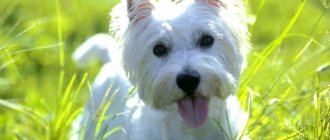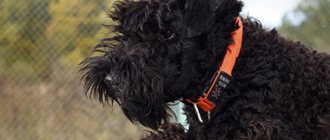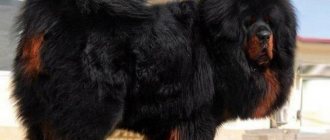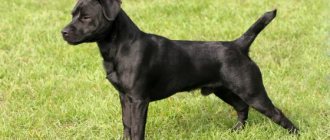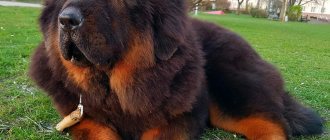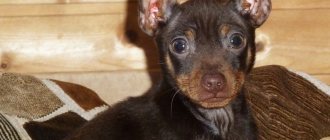The Tibetan Terrier, despite the name of the breed, is not one... The dogs received a similar name from the light hand of European tourists, to whom they resembled terriers.
The history of these cute, shaggy dogs is so ancient and hidden from researchers that much about them is still unknown. However, they once lived at Tibetan temples, serving as guards.
The modern Tibetan often acts as a companion, and his popularity is steadily growing.
History of the breed
The homeland of the Tibetan Terrier is Tibet.
The beginning of the history of this breed is lost in the distant past, long before the appearance of written sources. It is believed that the Tibetan terrier originated a thousand years ago. With the help of scientific research (DNA analysis), it was possible to prove that it originated from ancient breeds.
Tibet was a politically and geographically isolated place. Maybe it is because of this that Tibetan terriers for hundreds of years did not change their original appearance and remained purebred.
There is a version that terriers were originally bred in Tibet for herding work. If small puppies appeared in the brood that were not suitable for such use, they were given to Tibetan lamas for care.
Representatives of the breed were called “sacred dogs of Tibet.” They could not be sold, but only given as gifts. The monks believed that this dog brought good luck and happiness to the house and if it was sold, the prosperity would leave its owners.
At the beginning of history, the Tibetan was called the “Lhasa Terrier”. It was only in 1930 that it was recognized under the name "Tibetan Terrier".
Despite the name, the breed does not belong to terriers and has nothing in common with it. It’s just that the British, when they saw the Tibetans, decided that they were very similar to English terriers.
The Tibetan Terrier also came to Europe thanks to the British. In 1922, the Englishwoman Craig brought these dogs with her to her homeland from Tibet.
A short time later, she created the Lamleh Kennel kennel, which is now famous all over the world. Thanks to Craig, in 1937 the Tibetan Terrier breed was officially recognized as an independent species.
The Second World War, having almost destroyed many other dog species, practically did not affect the population of Tibetan terriers. In 1956, these terriers were brought to America. In the seventies of the twentieth century they were recognized by the AKC.
The Tibetan Terrier, being an ancient breed, served as the basis for the development of the Shih Tzu, the Tibetan spaniel.
Today, Tsang Apso is not very popular, but it is not in last place either. It is considered a rather rare and expensive species, the main purpose of which is as a companion dog.
Breed standard
The Tibetan Terrier is a medium-sized breed. He has a compact, square build with well-developed muscles. Adults look very much like a smaller version of the Old English Sheepdog.
The average weight of a mature Tibetan Terrier is 9-12 kg. , height at the withers is about 30-40 cm . Bitches are slightly smaller and lighter than males.
A not too large head rests on a strong, medium-length neck. The ears are hanging, V-shaped. They are covered with long, lush hair.
The eyes are large, round in shape, dark, set wide apart, and the eyelids are close-fitting.
The stop is well defined. The muzzle is of medium length. The nose is not too large and pigmented. Cheekbones do not protrude.
The jaws are strong, one might say powerful. The bite is scissor, but straight is allowed.
The top line is level, the back is strong and straight. The loin is muscular. The chest is quite voluminous. The tail is of medium length and set high. Twisted into a ring, well pubescent.
Limbs of medium length, smooth. A distinctive feature of the Tsang Apso is the shape of its paws. The Tibetan's paws resemble snowshoes in shape. They are large, wide, round in shape. A Tibetan with such paws can move through the snow relatively easily.
The coat of the Tibetan Terrier is long, thick, and soft. The guard hair is wavy but not curly. There is a dense, lush undercoat.
The color of the Tibetan Terrier is allowed in one-color, two-color, or tricolor. The rarest and most expensive is the golden Tsang Apso.
Origin of the breed
Genetic researchers have recently discovered that these terriers come from ancient breeds, and thanks to the isolation of Tibet, the purebred dogs were preserved for hundreds of years. The first individuals of this breed entered the territory of European countries in 1922, then an English doctor brought several terriers and local spaniels to Europe. She also became the founder of the first kennel of Tibetan terriers and sought to ensure that the breed received recognition from the English Kennel Club.
Today, Tibetan Terriers cannot be found on the lists of the most popular breeds, but they are popular in different countries and are increasingly attracting the attention of dog lovers.
Description of the Tibetan Terrier breed
A purebred representative of the breed has a strong, harmonious physique with massive bones. The dog's body is well muscled and covered with thick skin. Tibetan mastiffs have a clearly visible sexual type - males are more powerful, fluffy and stocky than females. When assessing standard data, more stringent requirements are imposed on male dogs.
weight of “Tibetans” does not depend on gender and varies from 8 to 14 kg, the height of males is 38-41 cm, females – 36-39 cm. The dog moves easily, without heaviness, freely.
By nature, this is a balanced, reserved dog, but at the same time lively and active. In any environment, the pet behaves confidently, attentively and responsively, and at first glance it becomes clear that this is an intelligent, physically strong and hardy animal.
In the standard, representatives of the breed are described as follows:
- The head is proportional, harmonious, medium in size, and in adults it is covered with long and thick hair. The forehead is moderately convex, not wide, and resembles a truncated wedge in shape. The back of the head is pronounced, but does not stand out like a tubercle. The eye sockets are moderately marked, hidden under the cascading spine. The transition from the frontal part to the muzzle is well expressed, it is emphasized by the silhouette line. The cheekbones are covered with lean muscles, the jaws are well developed.
- The facial area is not very dry, the bridge of the nose is straight, slightly narrowing closer to the lobe. The muzzle is neither pointed nor blunt. The lips are elastic, hide the teeth and tongue, the dentition is complete. The nose is medium-sized, black, with open, rounded nostrils.
- The shape of the eyes is close to round, they are large, expressive, with a confident look. The iris is pigmented in a rich brown hue. The eyelids fit tightly. Protruding or deeply sunken eyes are considered serious defects.
- Ears medium-sized, in the form of triangles, located high, but a vertical stance and rise are unacceptable, lowered to the head, but not pressed against it. Adults have beautiful, decorative fur on their ears.
- The body is square in shape, with a muscular neck covered with elongated hair, without a noticeable bend, and widening towards the shoulders.
- The withers are strong, but not protruding, covered with lean muscles. The sternum is oval-shaped and of decent depth. If it is flattened or not long enough, then this is a disadvantage.
- The back is shortened, level, muscular, without arching or bulging. The lumbar girdle is slightly protruding, muscular, moderately wide, not long. The abdominal line is moderately toned and well-chosen.
- The limbs are strong, covered with lean muscles, smooth, set parallel. The forelimbs are strong, but without heaviness, the muscles are pronounced, the angles of the joints are correct, the back of the paws is covered with long, decorative fur. The hind limbs are more powerful than the forelimbs, covered with long spines, but do not look rough or heavy. The articular angles are well defined, regular, limbs with powerful metatarsals, large hands, rounded, well assembled.
- The area between the toes is protected by thick fur. Dogs participating in exhibitions have it trimmed. The hands are directed forward.
- The size of the tail is related to the dog's height, but more often it reaches the hock joints. When the dog is at rest, the tail is located on the back, covered with long, decorative hair, which forms a tuft or falls apart in the form of a fountain - this depends on the length of the spine. The standard allows for a bend at the end of the tail.
Coat and colors
Tibetan Terriers have a two-layer coat consisting of a thick, dense, soft undercoat of decent length. In males it is better developed than in females. Tibetans have a long coat, it is tougher and thinner than the undercoat, and has an elastic structure. The coat is shiny in nature and has an even parting on the head and back.
A fluffy or very light coat is a serious fault. Dogs with coats that are too silky, curly, soft or heavy are also excluded from breeding.
At its natural length, the terrier's coat almost reaches the ground. The hair falling on the head and ears smoothly blends into the fur on the neck.
The bangs cover the eyes, and its ends blend into the hair covering the face. What remains open on this shaggy dog is his nose.
Tibetans have a natural color that harmonizes with the color of their earlobes, lips and eyelids. The standard allows for a variety of colors, one-color, two-color or more.
The main awn can be black, white, peach, cream, fawn, golden or gray - from blue to smoky shades. The most prized are those with golden fur.
They are often chosen as pets and talismans that bring good luck to the home.
Character and disposition of Tibetan terriers
Researchers believe that the Tibetan Terrier breed was originally bred for herding or farming. These dogs turned out to be real all-rounders and coped with a wide variety of jobs. Naturally, this fact, as well as life next to humans, could not but affect the character of the animals.
Unlike standard terriers, Tibetans are more patient and friendly; they always find a common language with children, even small ones, although if they get too bored, they may snap. But still, you should not get a pet if there is an expected addition to the family or if there is a baby.
The Tibetan Terrier quickly becomes attached to the family and strives to participate in all events. When alone, your pet becomes sad and may even become depressed. In addition, if the dog is often left alone, he may develop serious behavior problems.
The Tibetan with all his appearance and behavior shows how important he is for the family and successfully copes with the role of a guard. But his vigilance can be excessive. If the dog is not trained, he will bark loudly at the slightest provocation.
The dog is active and needs regular, long walks. During walks, the owner should be careful - if the pet becomes interested in something, he may start searching and get lost. Often the terrier is stubborn and, even hearing the owner’s voice, may not respond.
The dog is quite friendly and gets along well with other pets, including cats. But for this, the dog must undergo socialization while still a puppy. The dog should be taken outside, changed walking routes, visited different places, and introduced to other dogs and people.
Such a pet treats everyone in the household kindly, loves to sit on the arms to be caressed and shown attention. At the same time, he always happily responds to calls to play, and often becomes the instigator of fun activities. Even older people can have such a four-legged friend; he is moderately active and will not cause much trouble.
Maintenance and care
The Tibetan Terrier can be kept in the house or in an enclosure. It is medium in size, does not take up much space, is unpretentious, and its thick, dense coat with undercoat reliably protects from the cold.
With any method of keeping a Tibetan, physical activity is required. Every day you need to walk your pet at least twice. Walking at a slow pace is not suitable; they need to be alternated with running, jumping, and active games.
If you let a Tibetan off the leash, you must not let him out of your sight. He is very curious by nature and always strives to explore new places. Because of this habit, he is considered prone to escape.
The ideal place for keeping representatives of this breed is a private house with a spacious, fenced area. In such conditions, the pet will be able to freely walk in the yard at least every day. These dogs especially love to play in the snow; this is the best entertainment for them.
Caring for the Tibetan Terrier cannot be called too simple. But if you follow the procedures below in a timely manner, there will not be any special difficulties. Caring for representatives of the Tibetan breed is as follows:
- The long, lush coat of the Tibetan Terrier requires daily brushing. This will help avoid tangles and at the same time massage the skin. To make combing easier, it is recommended to moisturize the hair with special products before the procedure. Twice a year there is intense seasonal shedding; during this period it is important to take especially careful care of the coat.
- The Tibetan Terrier needs to be bathed quite often. The fur of such a dog does not have dirt-repellent properties. Due to its length, on the contrary, it collects all the debris and dirt. For bathing, you need to buy special products; “human” shampoo is not suitable, as it may cause an allergic reaction.
- The hair on the paw pads needs to be trimmed, it bothers the dog.
- We trim the claws as they grow.
- Tsang Apso's eyes are characterized by increased tearfulness. Because of this feature, it is recommended to wipe your eyes weekly using light tea leaves and napkins.
- Teeth are also considered the weak point of representatives of this breed. It is important to clean them weekly with a special non-foaming paste for dogs. To clean the teeth, it is recommended to let your pet chew hard vegetables, fruits and special bones from the veterinary pharmacy.
We provide balanced nutrition for the apso. An incorrectly composed diet contributes to the development of many diseases. 60-70% of the diet is protein food.
Dogs are not allowed to be given spices; salt is allowed in minimal quantities.
Health
On average, the Tibetan Terrier can live about 12-14 years, but there are cases of longevity when representatives of the breed could live 17 years or more.
Life expectancy directly depends on the conditions of detention and quality of nutrition. It is also important to carry out timely treatment for skin parasites, deworming and vaccination. Annual preventive examinations at a veterinary clinic are recommended.
The Tibetan Terrier has a predisposition to the following diseases:
- Dislocation of the eye lens is a severe pathology of the eyeball.
- Dysplasia is a developmental disorder of the hip joint, which leads to the development of arthrosis and destruction of the joint.
- Cataract is a clouding of the lens that impairs vision and can lead to complete loss of vision.
- Retinal atrophy is a genetic pathology that can lead not only to vision deterioration, but also to its loss.
- Dislocation of the kneecap is a displacement relative to its usual (normal) position outward (lateral) or inward (medially).
Health and life expectancy
With proper care and regular examinations by a veterinarian, proper physical activity and good nutrition, your pet will live on average: 14 – 18 years. There are predispositions to diseases:
- Organs of vision;
- Musculoskeletal system;
- Possible otitis;
- Allergic reactions.
Character
The character of the representatives of the breed is not at all the same as that of terriers. This is not surprising, because there is no blood relationship between them.
The Tibetan is absolutely happy only in the company of his beloved owners. It is family oriented. The character is playful. The dog always tries to participate in all household chores.
He is very attached to his family. Separation is difficult for him. Loneliness is not desirable for such dogs.
The Tibetan gets along well with children and is able to tolerate their pranks for a long time. But such a pet is recommended for school-age children, and not for toddlers.
Treats strangers with suspicion. Can serve as a guard.
Gets along well with pets. But he often shows jealousy. If the owner pays, for example, more attention to the cat, the terrier will try to correct the situation.
Tsang Apso loves to bark with or without reason. He may bark simply out of boredom or when he hears footsteps outside the door. To avoid discomfort in such cases for both the owners of the house and the neighbors, it is important to teach the terrier to stop barking on command.
The Apso has a supernatural sense, he acutely senses a person’s condition and behaves in a manner appropriate to the situation. This pet is perfect for those who have suffered from stress or are depressed. It has a positive effect on the nervous system and charges with optimism.
The Tibetan Terrier is neither shy nor aggressive. He is a calm, affectionate, loyal dog, provided he is properly trained and socialized.
Abstracts
- They are a great dog, but it is best to keep them in a home where the children are older.
- Gets along with other dogs and cats, but can be jealous.
- Requires care and frequent washing.
- Tibetan Terriers can be good sentinels, warning of the approach of strangers.
- If they take a daily walk, we get along well in the apartment.
- He is very attached to his family and cannot tolerate separation, loneliness, or lack of attention.
- Barking is the Tibetan Terrier's favorite pastime. He barks when someone comes to the door, when he hears something unusual and if he is bored.
Training and education
Raising and training a pet should begin from puppyhood. But this process can be problematic.
The fact is that the Tibetan Terrier puppy is not very disciplined. It is difficult for him to concentrate on one action, and he quickly loses interest in monotonous activities.
Based on the above, training lessons should be varied, interesting and not lengthy. During breaks, it is worth keeping your pet busy with a fun game, during which you can unobtrusively repeat already learned commands.
Despite the reluctance of the apso to train and teach commands, the owner must go through a general course of training and obedience with him. In this case, cruel and crude methods are excluded. The training is strict, but fair and calm.
Disobedience is especially acute at the age of 11-14 months.
Interesting Facts
- The Tibetan Terrier was kept by Tibetan monks for a long time, which is why it is often called the “holy dog of Tibet.”
- One in five Tibetan terriers lives more than 15 years; record cases of longevity up to 18 years are known.
- Tsang Apso is also called “little people” because of the ideal qualities of a companion dog and developed intelligence.
- The golden Tibetan Terrier enjoys special honor. The price for it is 2-3 times higher than usual. This color is extremely rare. An Apso with this color is the talisman of the house, bringing good luck.
- Tsang Apso was not allowed to be sold in Tibet. Such a dog could only be given to good people for good luck.
Mysterious dog - Tibetan terrier
Terriers from Tibet are one of the most mysterious dog breeds that have existed for more than two thousand years. These dogs invariably attract attention, their popularity in our country is constantly growing. From this article you will learn about the character traits of the holy Tibetan dogs, the reasons why they are called terriers, what are the rules for keeping them and what diseases are inherent in the breed.
Origin story
An interesting fact is that Tibetan terriers are not actually such. They were called terriers by Europeans who visited Tibet and China, since the animals’ appearance reminded them of familiar terriers.
The main version of the origin is the one that talks about the temple affiliation of dogs. Monks were engaged in breeding, believing in the holy essence of animals and their ability to ward off evil spirits and protect the home from them.
Among the population, it was considered a special honor to receive such a talisman in the form of a Tibetan terrier, which spoke of the special approval of the gods and promised protection from dark forces.
For a long time, terriers were prohibited from being exported outside the country. For such a crime the death penalty could be imposed. The first individuals were exported at the beginning of the 20th century, but this was only possible if the puppy was donated directly by the monk. Such a gift was given only as special respect or gratitude.
The first association of breed lovers was founded in England by the doctor Agnes Greig, who received several Tibetan terrier puppies as a sign of special gratitude for saving the life of the wife of a Tibetan rich man.
It was in England that Tibetan guests received the name terriers, while in their homeland they were called Tibetan apsos.
Official recognition occurred in the second half of the 20th century, but it is still considered small and rare. Interestingly, in their historical homeland there is no longer a ban on the export of Tibetan terrier puppies from the country. In addition, the monks give babies to those tourists who were able to overcome dangerous mountain heights.
flickr.com
Description of the breed
The appearance of long-haired Tibetans leaves no one indifferent. They are muscular and hardy, but due to their thick coat this is not always noticeable. This physique allows you to overcome steep mountain slopes, rocky areas and plains.
Tibetan terriers have clearly expressed sexual dimorphism: males are always more massive and larger than females. But the coat is the same in both sexes: long and thick, with an insulating short undercoat.
The color of dogs can be white, gray or creamy black. Almost any color is acceptable, except liver.
Standard
The latest breed standard was published in 2011. It includes indicators:
- height of males 36-41 cm, females 32-39 cm;
- weight of males 9-13 kg, females 7-10 kg;
- the head is small, the fur falls over the eyes, but does not interfere with looking;
- the jaws are well developed, the hair grows on the lower part, forming a beard;
- scissor bite shape;
- small muzzle;
- the nose is black or matches the color type;
- the eyes are round, brown with black eyelids;
- the ears droop, the fit is loose, they are hard to see because they are covered with hair;
- medium length tail set high;
- limbs are well developed;
- the coat is straight or wavy, but does not form a steep curl;
- life expectancy 12-14 years.
All deviations from standard indicators can be considered a disqualifying feature or defect, the severity of which is calculated in each specific case depending on the degree of severity.
wikimedia.org
Similar breeds
Although Tibetans are not terriers, but were bred more as herders, they are very similar in appearance to many terriers.
Bobtail
Outwardly, these dogs are very similar. The main difference is in size - the bobtail is noticeably larger, and its coat is much fluffier and thicker. The Tibetan looks like a dwarf bobtail.
Black Terrier
Outwardly they are very similar, but, as in the previous case, they are very different in size. Additionally, the Black Russian Terrier's coat may have a noticeable curl. The only acceptable color is black, while the Tibetan Terrier has a wide range of colors.
Character and behavioral characteristics
A characteristic feature of his character is his great friendliness and flexible nature. Dogs of this breed are devoid of aggression. Get along well with other pets. They are perfect for family life because they adore children.
Pros and cons of the breed
The Tibetan Terrier as a pet is suitable for both young families with children and elderly people. This breed is suitable for inexperienced dog owners. The main thing is that the owners love the Tibetan and provide him with the appropriate level of physical activity.
The main advantages of the Tibetan Terrier breed:
1. Beautiful appearance. 2. Friendly disposition. 3. Developed intelligence. 4. Refers to long-livers. 5. Good health. 6. Gets along well with other pets.
Origin story
Tibetan Terriers have nothing to do with terriers. The breed received this name for its resemblance to the small rodent fighters that were and remain popular in Great Britain. It is known that dogs of this type have been bred for centuries on the territory of the Tibetan Plateau, however, how these little helpers were used is not known for certain. There is an opinion that they were universal - they could work as shepherds or guard dogs, notifying larger guards of approaching danger.
A new era in the history of the breed begins in the 20s of the 20th century, when the English doctor Agnes Gray received a pair of Tibetan terriers as a gift from an Indian princess and brought them to Great Britain. She became the first person from Europe to receive puppies of this breed, valuable to Tibetans. Her dogs marked the beginning of the English dynasty of Tibetan terriers. Further breeding work took place in the UK. In 1957 the breed was recognized by the English Kennel Club.
Tibetan Terriers are often called “Tibetans” for short. Not to be confused with "Tibets", which are Tibetan Mastiffs, and "Tibbies", which is the name given to Tibetan Spaniels.
Video about Tibetan Terrier dogs:

